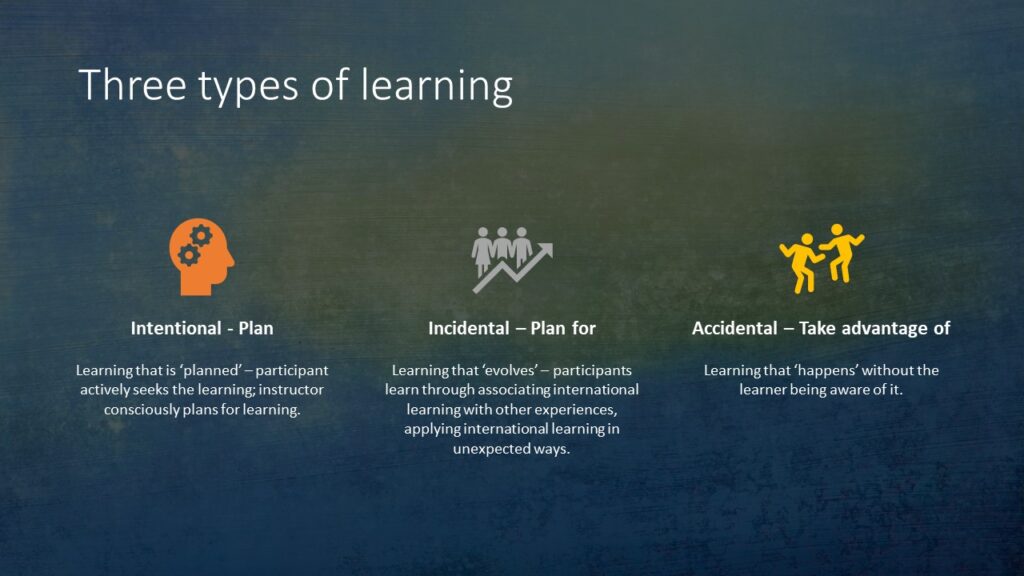Education is the kindling of a flame, not the filling of a vessel.
— Socrates
Teachers and trainers, students, employees, employers – COVID has changed the way work and learning is done. For the trainers, the task is find a way to convey the needed information while still managing the challenges that arise in the environment. In my previous article I highlighted some of the learning I have taken away from the past months, almost 2 years now! I’ve found we need to think in five key dimensions to make online learning effective. I’ve summarized them as STICK – Sequence, Technology, Interaction, Content and Knowledge. Today’s focus – the S in Stick – Sequence.
How can we sequence the material to promote engagement, addressing different competence levels and learning preferences? Let’s look at some adult education and training research.
How far back should we go? Well, we can start with Socrates – who was Plato’s teacher; and then to Plato – who was Aristotle’s teacher. Each of these three have a role to play in adult education theory which, at its essence, is linked to lifelong learning and growth.
Throughout history there have been various educational theories, usually developing and building on past experiences. As Aristotle said ‘What we have to learn to do, we learn by doing’. In the educational field, we have the opportunity to learn from what others have done.
In 1833, building on the Plato’s educational theory, Alexander Kapp introduced the term Andragogy in relation to adult education. Over a century later the term re-emerged in educational theory through Malcolm Knowles paper ‘Andragogy, not pedagogy’. Simply, andragogy summarizes the core principals of adult learning – adults need to feel in control of the learning, they bring a rich set of life experiences which can support their learning, and they learn best when they can clearly see the value and application of what’s being taught.
These concepts also sit well with Jean Piaget’s theory of discovery learning (learning best through doing) and David Kolb’s experiential learning theory – which follows the cycle of learning through defined stages based on experiences. When you add this all to the context of ‘Flow Theory’, the importance of sequencing learning becomes clear!
Excellence is not a gift but a skill that takes practice – Plato
Some techniques for sequencing learning include:
- Whole-part-whole – present the end ‘product’, deconstruct it, put it back together again… Another approach to this would be the EDIC model – Explain, Demonstrate, Imitate and Confirm.
- Known to unknown – focus on familiar topics, building on existing knowledge and common experiences, then add in new elements, keeping in mind the ‘flow’ theory concept of increasing complexity to promote learning, but not so much that the students begin to feel anxious and overwhelmed.
- Dependent / supportive relationships – look at the content critically and think about the dependent elements (for example – you must be able to do A before you can attempt B) and the supportive elements (those items that can be slotted in to enhance the learning, but are not critical to the next step).
Within the construct of the training, you can also think about the intentional, incidental, and accidental learning – and what you can do with the sequencing of activities to build these in, or provide opportunity to take advantage of the ‘teachable’ moment when it arises.
Intentional is the easiest – this is ‘what’ you are teaching, based on some objectives, standards, accredited program. Then you need to think about how to build in opportunity for incidental learning – the learning that happens with when students interact with the material and with each other; reaching some unintended conclusions that can be build on in the training to deepen understanding. To benefit from accidental learning, you need to be able to adapt to the outcomes of the activities with the students. What is something that has come about that wasn’t even thought about – but really fits with the topic?

When you start thinking critically about sequencing material for learning, there are many questions you can ask yourself – here are four to get you started!
1 – What is the overall objective for the learning (the outcome)?
2 – How can adult learning theory help with the instructional design?
3 – Which technique(s) can I use to support experiential learning?
4 – How can I use the sequence of content to support intentional and incidental learning, while providing the opportunity to build on accidental learning?
Whether we teach in the same physical space as our students, or if we are fully ‘online’, the sequence of the presentation of content is critical. This is a bit like putting the pieces of the puzzle together – working through different options, focusing on the outcomes, and being willing to adapt to get the sequence right.
Next – why having clear, well written objectives for learning are important…
Jillian Carson-Jackson, M.Ed, FNI, FRIN
4 December 2021

